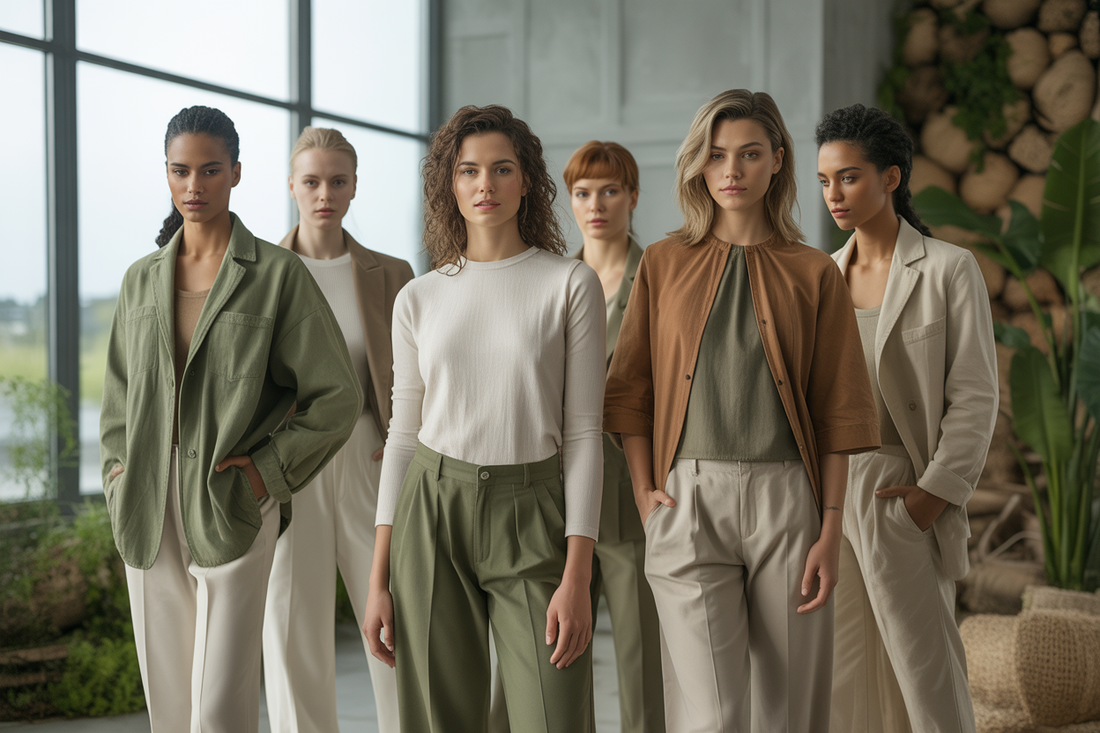
Sustainable Fabrics in Fashion | Eco-Friendly Materials 2025
Share
The Urgency of Sustainable Fashion
The fashion industry is at a turning point. Our planet is facing a crisis, and fashion has a huge role to play in it. It’s been one of the most significant contributors to waste and pollution for years. Yet, this challenge brings a powerful opportunity. Fashion can shift toward sustainability, and eco-friendly fabrics are at the forefront of that change. These materials aren’t just a trend; they are a revolution in how fashion can grow while protecting the environment.
In 2025, sustainable fashion will not be optional—it will be a necessity. Younger generations, especially Millennials and Gen Z, are leading this charge. They want brands that care about the planet and offer products with purpose. The conversation is no longer just about looking good. It’s about making choices that matter—choices that make a difference.
By choosing eco-friendly fabrics, you’re not just responding to demand. You’re setting the stage for long-term success. Brands that embrace sustainable fabrics today will be the leaders of tomorrow. The change isn’t coming—it’s already here.
This is more than just an ethical choice; it’s a smart business move. Sustainable fabrics open doors to new markets, loyal customers, and a competitive edge. The future of fashion is sustainable, and the sooner you embrace it, the better. Let’s examine the materials driving this change and how you can participate.
Understanding Sustainable Fabrics: Types and Benefits
Sustainable fabrics are changing the way we see fashion. These materials help reduce the environmental impact of the fashion industry. They are made with eco-friendly methods and come from renewable resources. This differs from traditional fabrics, which are often made using harmful chemicals and wasteful practices.

Here are some popular sustainable fabrics:
-
Organic Cotton: This cotton is grown without harmful pesticides or fertilizers. It uses less water and is better for the soil, making it a much greener option than regular cotton.
-
Hemp: Hemp is a strong, durable fabric that grows quickly. It needs little water and no pesticides, making it one of the most eco-friendly options. It’s also biodegradable.
-
Tencel (Lyocell): Tencel is made from wood pulp, usually from eucalyptus trees. It’s produced in a closed-loop system that recycles water and solvents, making it a sustainable choice. It’s soft, breathable, and kind to the planet.
-
Bamboo: Bamboo grows fast and needs little water. It doesn’t require pesticides either. When processed responsibly, it makes a sustainable fabric that is biodegradable.
These fabrics offer many benefits beyond being eco-friendly. Consumers are now looking for brands that offer products that align with their values. Using sustainable materials, your brand can meet this growing demand, build stronger customer loyalty, and stand out in a crowded market.
Sustainable fabrics can also help lower production costs in the long run. They use less water and energy, making your brand more efficient. Choosing sustainable fabrics not only helps the planet—it can also boost your brand’s success.
Now that we understand what sustainable fabrics are and their benefits, it’s clear why they’re essential for the future of fashion. Adopting these materials can lead to a more sustainable fashion industry.
Why Eco-Friendly Materials Are a Game-Changer for Fashion
Fashion is at a significant turning point. With the planet in crisis, consumers are demanding more sustainable options. Eco-friendly materials offer a robust solution. Here’s why they matter.

Environmental Impact: Reducing Harm
Traditional fabrics, especially synthetics, have a significant impact on the environment. They require a lot of water and often use harmful chemicals, leading to pollution and waste.
Eco-friendly materials like organic cotton, hemp, and bamboo are much cleaner. They grow quickly, need less water, and don’t rely on harmful pesticides. Choosing these materials can reduce pollution and make fashion more sustainable.
Consumer Demand: Shopping with Purpose
Today’s shoppers are more aware than ever of the impact of their choices. Millennials and Gen Z, in particular, want to support brands that care about the planet. They’re willing to pay more for clothing made with eco-friendly materials.
For fashion brands, this shift is an opportunity. Those that embrace sustainability can attract these conscious shoppers, and brands that don’t risk being left behind can attract them.
Brand Loyalty: Gaining Trust
In a crowded market, standing out is key. Eco-friendly fabrics help brands build trust and loyalty. When customers see that a brand is committed to the environment, they are more likely to return.
This is not just about today—it’s about building long-term customer relationships. Sustainable fashion is more than a trend—it’s the future.
Long-Term Savings and Efficiency
Sustainable fabrics can save money in the long run. While the upfront cost may be higher, these materials produce less water and energy. Over time, this reduces operational costs.
Also, as demand for eco-friendly fabrics grows, prices may drop, making them more accessible. Brands that invest in these materials now will see a return on investment.
In conclusion, eco-friendly materials are shaping the future of fashion. They reduce environmental harm, attract conscious consumers, and offer long-term savings. Brands that lead the way now will thrive tomorrow.
Integrating Sustainable Fabrics into Your Fashion Brand
Sustainability is reshaping the fashion industry. It’s not just about eco-friendly materials. It’s about creating a brand that values the planet and its people. Let’s explore how you can make this shift and build a future-proof fashion brand.
Choosing the Right Sustainable Fabrics
The first step is choosing the right fabrics. Look for materials like organic cotton, hemp, and Tencel. Organic cotton uses less water and no harmful chemicals. Hemp grows fast with little water. Tencel is made with a closed-loop system that recycles water and solvents.
When picking fabrics, think about your audience. Luxury shoppers may love organic silk, while younger, eco-conscious buyers prefer bamboo or recycled polyester. Choose materials that align with your brand’s identity and values.
Building a Sustainable Supply Chain
Your commitment to sustainability doesn’t stop with the fabric. You need a supply chain that matches these values. Work with suppliers who follow ethical practices, reduce waste, and minimize their environmental impact.
Consider a closed-loop system, where materials are recycled. Choose manufacturers that use eco-friendly dyes and save water in their processes. This will help strengthen your brand’s eco-friendly reputation.
Designing for Longevity
Sustainable fashion is not just about the materials; it’s about the design. Create clothing that lasts. Focus on timeless designs and durable materials. Customers who buy high-quality, long-lasting pieces are less likely to discard them quickly.
Consumers today value quality and longevity. Designing products that can withstand time reduces waste and promotes a more sustainable consumption cycle.

Innovating for the Future
Sustainability doesn’t stop with today’s practices. The future of fashion lies in innovation. Explore cutting-edge technologies like 3D printing and upcycling. These methods reduce waste and help create new, sustainable options.
You can also innovate with eco-friendly packaging. Use biodegradable materials or recycled packaging to align with your sustainability goals. Staying ahead of the curve with these innovations will set your brand apart.
Final Thoughts:
Sustainable fashion is no longer an option—it’s a necessity. As the world turns its focus toward environmental responsibility, the fashion industry is rising to the challenge. By adopting eco-friendly fabrics, you’re not just making a responsible choice—you’re positioning your brand for the future.
For BRANCHE LONDON, integrating sustainable fabrics is more than aligning with a trend. It’s about building long-term trust with customers who care deeply about sustainability. Consumers today want brands that reflect their values. They want to support businesses prioritizing the planet while delivering high-quality, stylish products.
Now is the time to act. Your brand can lead the way toward sustainable fashion by embracing eco-friendly materials. By doing so, you’ll set your brand apart and build a loyal, engaged audience that believes in your mission.
We’d love to hear from you! Share your thoughts on sustainable fashion in the comments. Found value in this? Share it with those who care about making a positive impact. And don’t forget to explore our exclusive, eco-friendly collection at BRANCHE LONDON, where style meets sustainability.
